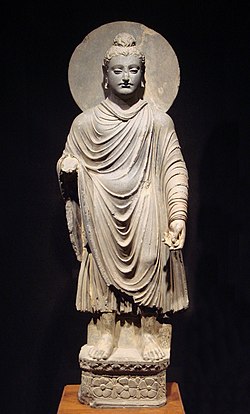Top Qs
Timeline
Chat
Perspective
Rosette (design)
Round, stylized flower design From Wikipedia, the free encyclopedia
Remove ads
A rosette (rarely spelled roset[1]) is a round, stylized flower design.

Origin
The rosette derives from the natural shape of the botanical rosette, formed by leaves radiating out from the stem of a plant and visible even after the flowers have withered.
History
The rosette design is used extensively in sculptural objects from antiquity, appearing in Mesopotamia, and in funeral steles' decoration in Ancient Greece. The rosette was another important symbol of Ishtar which had originally belonged to Inanna along with the Star of Ishtar.[2]
It was adopted later in Romaneseque and Renaissance architecture, and also common in the art of Central Asia, spreading as far as India where it is used as a decorative motif in Greco-Buddhist art.
Remove ads
Ancient origins
One of the earliest appearances of the rosette in ancient art is in early fourth millennium BC Egypt.[3] Another early Mediterranean occurrence of the rosette design derives from Minoan Crete; Among other places, the design appears on the Phaistos Disc, recovered from the eponymous archaeological site in southern Crete.[4]
- Greco-Buddhist rosettes at the bottom of a statue of the Buddha from Gandhara, 1st-2nd century AD, schistose rock, Tokyo National Museum
Modern use
The formalised flower motif is often carved in stone or wood to create decorative ornaments for architecture and furniture, and in metalworking, jewelry design and the applied arts to form a decorative border or at the intersection of two materials.
Rosette decorations have been used for formal military awards. They also appear in modern, civilian clothes,[5] and are often worn prominently in political[6] or sporting[7] events. Rosettes sometimes decorate musical instruments, such as around the perimeter of sound holes of guitars.
Remove ads
Gallery
- Priest-King, a Harappan artwork, 2400–1900 BC, low fired steatite, National Museum of Pakistan, Karachi
- Minoan rosettes on a fresco from Akrotiri, 17th century BC, fresco, Museum of Prehistoric Thera, Thera, Santorini, Greece
- Ancient Egyptian rosettes on a ceiling painting from the palace of Amenhotep III, c.1390–1353 BC, dried mud, mud plaster and paint Gesso, Metropolitan Museum of Art, New York City
- Ancient Egyptian rosettes on the wooden chest of Tutankhamun, 1336-1327 BC, wood inlayed with ivory, Egyptian Museum, Cairo[9]
- Mycenaean volutes, part of a mural from a palace in Tiryns, Greece, 13th century BC, fresco, Archaeological Museum of Nafplion, Nafplio, Greece
- Babylonian glazed brick fragments with rosette decoration, 539-330 BC, burned and glazed clay, Vorderasiatisches Museum Berlin
- Ancient Greek rosettes around a door of the Erechtheion, Athens, Greece, unknown architect, 421-405 BC[11]
- Ancient Greek rosettes on a lekythos with Aphrodite rising from the sea, 4th century BC, ceramic, Museum of Fine Arts, Boston, US[12]
- Ancient Greek rosettes on a pendant, 4th century BC, gold, National Archaeological Museum of Taranto, Taranto, Italy[13]
- Ancient Greek rosettes on a larnax of Philip II, 330-320 BC, gold and enamel, Museum of the Royal Tombs of Aigai, Vergina, Greece[14]
- Roman rosettes in the ceiling of the Arch of Septimius Severus, Rome, unknown architect, 203
- Roman rosettes on a frieze, unknown date, probably marble, Villa medicea di Cerreto Guidi, Cerreto Guidi, Italy
- Romanesque rosettes on a pair of capitals from the Vézelay Abbey, Vézelay, France, unknown architect, 1120-1150
- Tudor rose added under Henry VIII to the foot of the Gothic Royal Gold Cup, late 14th century, British Museum
- Baroque rosettes on a carpet with fame and fortitude, by the Savonnerie manufactory, 1668–1685, knotted and cut wool pile, woven with about 90 knots per square inch, Metropolitan Museum of Art
- Rosettes, 17th or 18th centuries, print, Cooper Hewitt, Smithsonian Design Museum, New York City
- Rosettes, 17th or 18th centuries, print, Cooper Hewitt, Smithsonian Design Museum
- Rosettes, 17th or 18th centuries, print, Cooper Hewitt, Smithsonian Design Museum
- Neoclassical rosettes in the Arc de Triomphe du Carrousel, Paris, by Charles Percier and Pierre-François-Léonard Fontaine, 1806-1808
- Neoclassical rosettes on the arms of an armchair, by Jacob Desmalter, 1808, gilded wood, Louvre
- Neoclassical rosettes on a stool, by François-Honoré-Georges Jacob-Desmalter, c.1810, gilded wood, unknown location
- Neoclassical rosettes on a vase, by the Sèvres Porcelain Manufactory, 1814, hard-paste porcelain with platinum background and gilt bronze mounts, Louvre[15]
- Neoclassical rosettes on the dome of the Crematorium of the Père-Lachaise Cemetery, Paris, by Jean Camille Formigé, 1886
- Simplified Neoclassical rosettes of a door of the Romanian Atheneum, Bucharest, Romania, by Albert Galleron, 1888
- Rosettes on the Beaux-Arts fence of Strada Ionel Perlea no. 21, Bucharest, unknown architect, c.1900
- Art Nouveau rosettes on a gate of the Longoria Palace, Madrid, Spain, by José Grases Riera, 1902-1904
- Neoclassical rosette on a handle of the lateral wing that faces Strada Edgar Quinet and Strada Academiei of the University Building, Bucharest, Romania, probably designed by Nicolae Ghica-Budești, 1914-1934[16]
- Rosettes on Beaux-Arts balconies of Strada Episcopiei no. 2-4, Bucharest, unknown architect, c.1920
- Art Deco rosettes on Strada Grigore Cobălcescu no. 56, Bucharest, unknown architect, c.1930
Remove ads
See also
Footnotes
Wikiwand - on
Seamless Wikipedia browsing. On steroids.
Remove ads









































